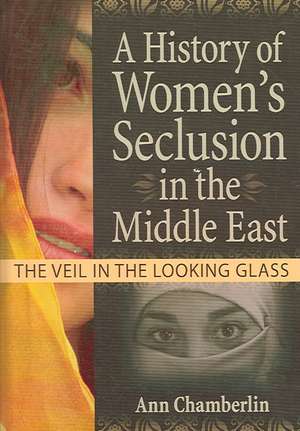A History of Women's Seclusion in the Middle East: The Veil in the Looking Glass
Autor J. Dianne Garner, Linn Prentisen Limba Engleză Hardback – 17 oct 2006
Internationally acclaimed author Ann Chamberlin’s book, A History of Women’s Seclusion in the Middle East: The Veil in the Looking Glass is a critical interdisciplinary examination of the practice of seclusion of women throughout the Middle East from its beginnings. This challenging exploration discusses the reasons that seclusion may not be as oppressive as is presently generally accepted, and, in fact, may be an empowering force for women in both the West and East. Readers are taken on a controversial, belief-bending journey deep into the surprising origins and diverse aspects of female seclusion to find solid evidence of its surprising use as a defense against monolithic cultural exploitation.
The author uses her extensive knowledge of Middle Eastern culture, language, and even archeology to provide a convincing assertion challenging the Western view that seclusion was and is a result of women’s oppression. A History of Women’s Seclusion in the Middle East goes beyond standard feminist rhetoric to put forth shocking notions on the real reasons behind women’s seclusion and how it has been used to counteract cultural exploitation. The book reviews written evidence, domestic and sacred architecture, evolution, biology, the clan, the environment for seclusion, trade, capital and land, slavery, honor, and various other aspects in a powerful feminist argument that seclusion is actually a valuable empowering force of protection from the influence of today’s society. The text includes thirty black and white figures with useful descriptions to illustrate and enhance reader understanding of concepts.
A History of Women’s Seclusion in the Middle East discusses at length:
- prehistoric evidence of seclusion
- the sense of honor in the Middle East
- a balanced look at the Islamic religion
- the true nature of the harem
- the reasons for the oppression by the Taliban
- the positive aspects of ’veiling’
- seclusion as a defense against capitalist exploitation
- and other challenging perspectives!
Preț: 253.21 lei
Preț vechi: 299.38 lei
-15% Nou
Puncte Express: 380
Preț estimativ în valută:
48.46€ • 50.40$ • 40.00£
48.46€ • 50.40$ • 40.00£
Carte tipărită la comandă
Livrare economică 14-28 aprilie
Preluare comenzi: 021 569.72.76
Specificații
ISBN-13: 9780789029836
ISBN-10: 0789029839
Pagini: 314
Ilustrații: Illustrations, maps
Dimensiuni: 148 x 210 x 25 mm
Greutate: 0.74 kg
Ediția:1
Editura: Taylor & Francis
Colecția Routledge
Locul publicării:Oxford, United Kingdom
ISBN-10: 0789029839
Pagini: 314
Ilustrații: Illustrations, maps
Dimensiuni: 148 x 210 x 25 mm
Greutate: 0.74 kg
Ediția:1
Editura: Taylor & Francis
Colecția Routledge
Locul publicării:Oxford, United Kingdom
Cuprins
- Foreword (Peter Lamborn Wilson)
- Acknowledgments
- Introduction
- Chapter 1. Seclusion at Work
- Examples
- A Return to the Taliban
- Chapter 2. Ancient Veiling
- Artistic Representation
- Written Evidence
- Chapter 3. Domestic Architecture
- Chapter 4. Architecture: The Sacred
- In the Sacred Storehouse
- Sacred Pegs
- “HRM”
- Chapter 5. Balance in the Paleolithic: Sacred Time, Space, and Persons
- Chapter 6. Evolution
- Chapter 7. Biology
- Chapter 8. The Clan
- Chapter 9. Environment for Seclusion
- Chapter 10. Trade
- Chapter 11. Capital and Land
- The British Parallel: Enclosure
- Chapter 12. Liberation of the Individual
- The Hunger for the Individual
- The Urban Mesopotamian Clan
- How Mesopotamian Culture Effected Individual Alienation
- The Personal God
- Chapter 13. Cities of Power
- Chapter 14. Vernacular Gender
- Chapter 15. Slavery
- Chapter 16. Honor
- Chapter 17. Masscult
- Chapter 18. Women’s Tongue
- Chapter 19. For Men Only
- Chapter 20. The Fate of Seclusion in the West
- Chapter 21. Conclusion
- Notes
- Bibliography
- Index
Descriere
Internationally acclaimed author Ann Chamberlin's book, A History of Women's Seclusion in the Middle East: The Veil in the Looking Glass is a critical interdisciplinary examination of the practice of seclusion of women throughout the Middle East from its beginnings. This challenging exploration discusses the reasons that seclusion may not be as oppressive as is presently generally accepted, and, in fact, may be an empowering force for women in both the West and East. Readers are taken on a controversial, belief-bending journey deep into the surprising origins and diverse aspects of female seclusion to find solid evidence of its surprising use as a defense against monolithic cultural exploitation.
